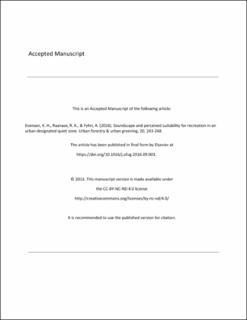| dc.contributor.author | Evensen, Katinka Horgen | |
| dc.contributor.author | Raanaas, Ruth Kjærsti | |
| dc.contributor.author | Fyhri, Aslak | |
| dc.date.accessioned | 2021-03-23T08:29:26Z | |
| dc.date.available | 2021-03-23T08:29:26Z | |
| dc.date.created | 2016-10-03T15:37:54Z | |
| dc.date.issued | 2016-09-16 | |
| dc.identifier.citation | Urban Forestry & Urban Greening. 2016, 20 (December), 243-248. | en_US |
| dc.identifier.issn | 1618-8667 | |
| dc.identifier.uri | https://hdl.handle.net/11250/2734960 | |
| dc.description.abstract | Green urban parks can offer city dwellers a place to withdraw from traffic noise. However, the significance of the sonic environment for suitability for recreational activities and how to measure this in an appropriate manner, has not been given much research attention. The aim of the study was to investigate the relation between calculated estimates of noise and the soundscape disclosing its suitability for recreation, and to compare three methods of measuring soundscape in an urban park designated as a quiet zone in Oslo. A soundwalk (N = 14) and an on-site survey (N = 99) were conducted in three different noise zones inside the park, and an off-site survey was conducted outside the park (N = 99). The study indicated that the soundwalk method was better at discriminating between the calculated high, medium and low noise zones in terms of the effect on perceived annoyance of traffic noise and suitability for recreational activities and potential for restoration. People outside the park expected the perceived annoyance of the traffic noise inside the park to be higher, and the potential for stress recovery to be lower than those asked in the lowest noise zone inside the park. The study points at the importance of protecting against road traffic noise in urban green areas to facilitate for recreational activities, and brings up pertinent methodological issues for the research on soundscape. | en_US |
| dc.language.iso | eng | en_US |
| dc.publisher | Elsevier GmbH | en_US |
| dc.rights | Attribution-NonCommercial-NoDerivatives 4.0 Internasjonal | * |
| dc.rights.uri | http://creativecommons.org/licenses/by-nc-nd/4.0/deed.no | * |
| dc.title | Soundscape and perceived suitability for recreation in an urban designated quiet zone | en_US |
| dc.type | Journal article | en_US |
| dc.type | Peer reviewed | en_US |
| dc.rights.holder | © 2016 Elsevier GmbH. All rights reserved. | en_US |
| dc.description.version | acceptedVersion | en_US |
| cristin.ispublished | true | |
| cristin.fulltext | postprint | |
| cristin.qualitycode | 1 | |
| dc.identifier.doi | 10.1016/j.ufug.2016.09.003 | |
| dc.identifier.cristin | 1389109 | |
| dc.source.journal | Urban Forestry & Urban Greening | en_US |
| dc.source.volume | 20 | en_US |
| dc.source.issue | December | en_US |
| dc.source.pagenumber | 243-248 | en_US |

